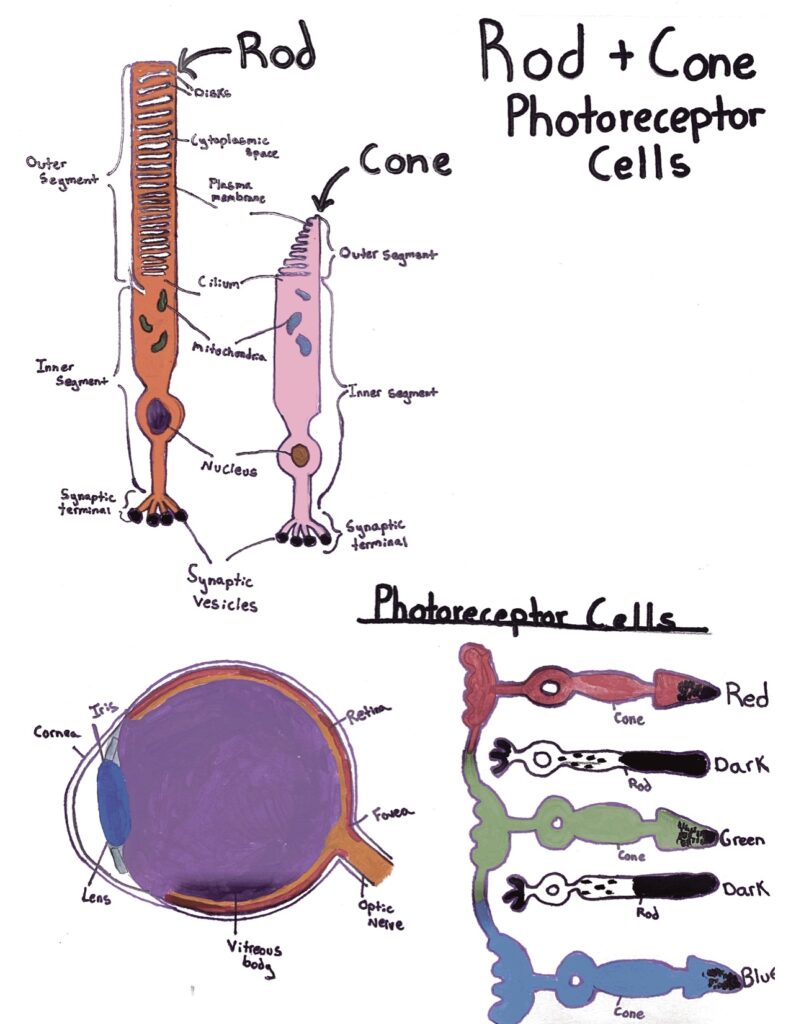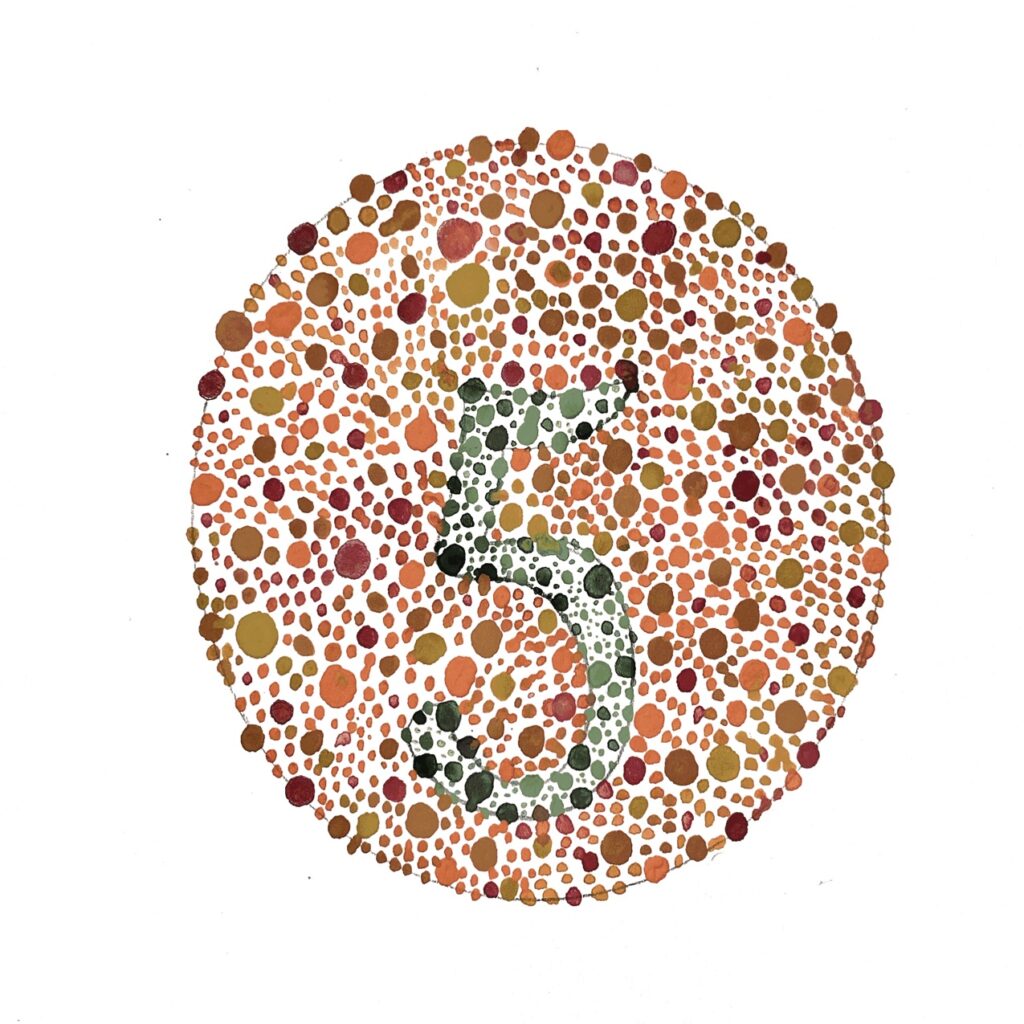My STEAM project will be focused on the different ways light processes through the eye in colorblind people and non-colorblind people. It will also focus on the various structures of the cone photoreceptors and how they differ in function and form. I will relate the objective of comparing and contrasting sensory cells, in this case, photoreceptors. I find colorblindness to be an unfortunate thing to have but yet interesting. Could you imagine living your life not being able to see the colors that everybody else sees?
There are approximately 300 million people who are colorblind in the world. Color vision deficiency can often be inherited or caused by eye diseases or medications. Photoreceptors can be defined as neurons that have the function of converting light into electrical signals, which then can be stimulated in the retinas of the eyes. Photoreceptors are different from other sensory cells because they show a change in the membrane potential in the response of light instead of an action potential.
So to understand how people are colorblind and what that looks like, we must know why we see color. We will see color when light photons go through our eyes to the retina; this causes the excitation of protein receptors in our retina, which leads to an enzyme reaction. On our retina, there are many different cells called rods and cones. All of these different rod and cone cells on our retina send electrical signals to our brain, saying what we are seeing. It depends on the rod and cone cells to react to colors and wavelengths. Our optic nerve is connected directly to our thalamus. The thalamus receives the information from the optic nerves and sends it to the visual cortex. Cells in the visual cortex look for different things like colors, shapes, and words.
So why are some people colorblind? A person’s visual perception of colors begins with photons with different energies which travel to the rods and cones—those rods and cones process color in a non-color blind person. In a person who is colorblind, those rods and cones have variations or mutations which make them unable to process the color correctly. People that are colorblind can also not have some of those rods and cones, or they do not function properly.
There are three types of cone photoreceptors: red, blue, and green. These cones line the retina along with the rods. In colorblind people, some of those cones stop working, so if your red cone is no longer functioning, you will have a hard time seeing red or colors containing red—the same thing for blue and green cones. You would not see green if the green cone was impaired or blue if the blue cone was impaired. If only one cone were damaged, a person would still be able to see color usually. Color Blindness only occurs when two or more cones are no longer functioning correctly; this is why there are three types of colorblindness. There is red-green, blue-yellow, or complete loss of color which is rare.
References:
Department of Pharmacology and Cleveland Center for Membrane and structural biology. (2015, May 19). Advances in understanding the molecular basis of the first steps in color vision. Redirecting. Retrieved November 20, 2021, from https://doi.org/10.1016/j.preteyeres.2015.07.004.
Patterson, E. J., Wilk, M., Langlo, C. S., Kasilian, M., Ring, M., Hufnagel, R. B., Dubis, A. M., Tee, J. J., Kalitzeos, A., Gardner, J. C., Ahmed, Z. M., Sisk, R. A., Larsen, M., Sjoberg, S., Connor, T. B., Dubra, A., Neitz, J., Hardcastle, A. J., Neitz, M., … Carroll, J. (2016, July 1). Cone photoreceptor structure in patients with X-linked cone dysfunction and red-green color vision deficiency. Investigative Ophthalmology & Visual Science. Retrieved November 20, 2021, from https://iovs.arvojournals.org/article.aspx?articleid=2538290.
Carroll, J., Neitz, M., Hofer, H., Neitz, J., & Williams, D. R. (2004, June 1). Functional photoreceptor loss revealed with adaptive optics: An alternate cause of colorblindness. PNAS. Retrieved November 20, 2021, from https://europepmc.org/article/MED/15148406.



In this steam project, Halene tells us about the disorder of color blindness. A topic which i was very unfamiliar and honestly, pretty confused about. First, she gives us some statistics on the disorder. It really brought to light how many people actually suffer from color blindness. Then, she dives into the anatomy of the eye, painting a picture in our mind. (No pun intended:) ) She describes how the eye produces light into electrical signals in the brain, specifically the thalamus, to see color. She points out what parts of the eye are responsible for receiving color, which are the rods and cones. These cones and rods convert the light depending on color and wavelengths. Another thing I learned is the different cones for different colors; specifically red, green and blue cones. Lastly in her paper she describes how color blindness actually happens and where in the process it goes wrong. To my surprise it happens pretty early in the process, in the red green, and blue cones. Some cones can be damaged, mutated, variated, or not even there. Causing the lack of that color being able to be processed. Halene made a great choice on her medium for this project; allowing us to see what the cones and rods in our eyes look like and the physiology of them. I believe that my favorite drawing is the Ishihara drawing. It was a nice touch.